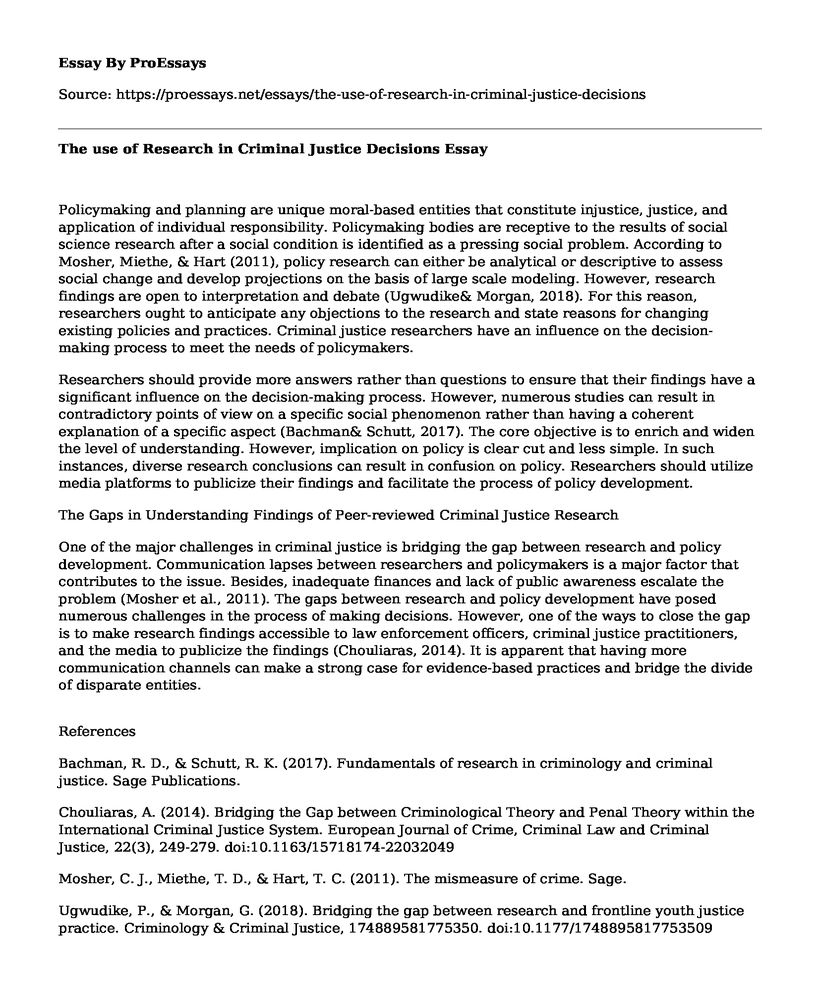Policymaking and planning are unique moral-based entities that constitute injustice, justice, and application of individual responsibility. Policymaking bodies are receptive to the results of social science research after a social condition is identified as a pressing social problem. According to Mosher, Miethe, & Hart (2011), policy research can either be analytical or descriptive to assess social change and develop projections on the basis of large scale modeling. However, research findings are open to interpretation and debate (Ugwudike& Morgan, 2018). For this reason, researchers ought to anticipate any objections to the research and state reasons for changing existing policies and practices. Criminal justice researchers have an influence on the decision-making process to meet the needs of policymakers.
Researchers should provide more answers rather than questions to ensure that their findings have a significant influence on the decision-making process. However, numerous studies can result in contradictory points of view on a specific social phenomenon rather than having a coherent explanation of a specific aspect (Bachman& Schutt, 2017). The core objective is to enrich and widen the level of understanding. However, implication on policy is clear cut and less simple. In such instances, diverse research conclusions can result in confusion on policy. Researchers should utilize media platforms to publicize their findings and facilitate the process of policy development.
The Gaps in Understanding Findings of Peer-reviewed Criminal Justice Research
One of the major challenges in criminal justice is bridging the gap between research and policy development. Communication lapses between researchers and policymakers is a major factor that contributes to the issue. Besides, inadequate finances and lack of public awareness escalate the problem (Mosher et al., 2011). The gaps between research and policy development have posed numerous challenges in the process of making decisions. However, one of the ways to close the gap is to make research findings accessible to law enforcement officers, criminal justice practitioners, and the media to publicize the findings (Chouliaras, 2014). It is apparent that having more communication channels can make a strong case for evidence-based practices and bridge the divide of disparate entities.
References
Bachman, R. D., & Schutt, R. K. (2017). Fundamentals of research in criminology and criminal justice. Sage Publications.
Chouliaras, A. (2014). Bridging the Gap between Criminological Theory and Penal Theory within the International Criminal Justice System. European Journal of Crime, Criminal Law and Criminal Justice, 22(3), 249-279. doi:10.1163/15718174-22032049
Mosher, C. J., Miethe, T. D., & Hart, T. C. (2011). The mismeasure of crime. Sage.
Ugwudike, P., & Morgan, G. (2018). Bridging the gap between research and frontline youth justice practice. Criminology & Criminal Justice, 174889581775350. doi:10.1177/1748895817753509
Cite this page
The use of Research in Criminal Justice Decisions. (2022, Dec 05). Retrieved from https://proessays.net/essays/the-use-of-research-in-criminal-justice-decisions
If you are the original author of this essay and no longer wish to have it published on the ProEssays website, please click below to request its removal:
- Zimmermann Telegram: America Enters the War Essay
- Overview of Human Resource Management - Essay Sample
- Case Study on Wells Fargo Ethical Problem
- Essay on Founding Fathers & US Constitution: The Federalists & Anti-Federalists
- 83% Open-Minded: My Personality Traits Revealed - Essay Sample
- Non-Profits: Challenges, Deaths, Rebrands, and More - Research Paper
- Essay Sample on Social Media Marketing: A Growing Trend in Academia







